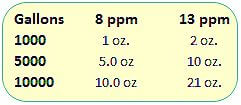Outdoor pool.
My guards checked chemicals last night and got under 20 for CYA.
Last known FC was 1.4
My training and CDC guidelines say CYA under 15, FC to 40 and maintain for 8.5 hours. No mandated maximum, I'd probably feel comfortable letting swimmers return under 20 FC and I'd be happier about under 15ppm
That is enough outside of our guidelines to say that we are not the right place to advise you.
We follow the
FC/CYA Levels and say that it si safe to swim up to SLAM FC for your CYA level.
For a residential pool we would say that with CYA 20 the sun will rapidly lower the FC level.
From
Free Chlorine - Further Reading
How Can Free Chlorine be Lowered in Pool Water?
In outdoor pools free chlorine will naturally decline 2-4 ppm a day due to the sun.
There are chlorine neutralizers most likely contain sodium thiosulfate.
- Add Sodium Thiosulfate, aka Chlorine Neutralizer for instant reduction.
- Add Ascorbic Acid, aka Vitamin C to remove chlorine.
- Add Hydrogen Peroxide, aka H2O2, to breakdown chlorine.
- Remove chlorine naturally with sunlight, aeration and agitation of the water.
Sodium Thiosulfate, add 2 oz per 10,000 gallons of pool water to lower chlorine level by 1.0 ppm.Probably the cheapest and most reliable method to lower chlorine levels, in pools or spas.
[1]
Ascorbic Acid – yes, granular Vit C! Add 32 oz per 10,000 gallons of pool water to lower chlorine level by about 9 ppm.
Hydrogen Peroxide – use 1 gallon of Aqua Silk Oxidizer per 10,000 gallons of pool water to lower chlorine level by 55 ppm. For spas, use 3% drug store peroxide, 2 ounces per 100 gallons of spa water, to lower chlorine (or bromine) level by about 10 ppm.
For Sodium Thiosulfate, add about a cup (8 oz) of the dry white crystals per 5,000 gallons of pool water, or 1 oz per 100 gallons – to lower chlorine by 10 ppm. Check your pool water pH and adjust to within label instructions, and add directly to the pool or spa.

Sodium thiosulfate dosage In pools and spas, you want to be careful not to overshoot the mark, or overdose the pool with Sodium Thio, or you may have difficulty adding new chlorine, temporarily at least. Sodium Thiosulfate will dissipate from most pools within a few days. Follow the label instructions carefully when using a chlorine remover, for recommended water balance and dosages.
Another good resource is this
sodium thiosulfate calculator on Koiphen.com – enter your pool size in gallons (or liters) and the current chlorine level in ppm, and it tells you how many ounces or grams of Sodium Thiosulfate to add to reduce chlorine to zero.


